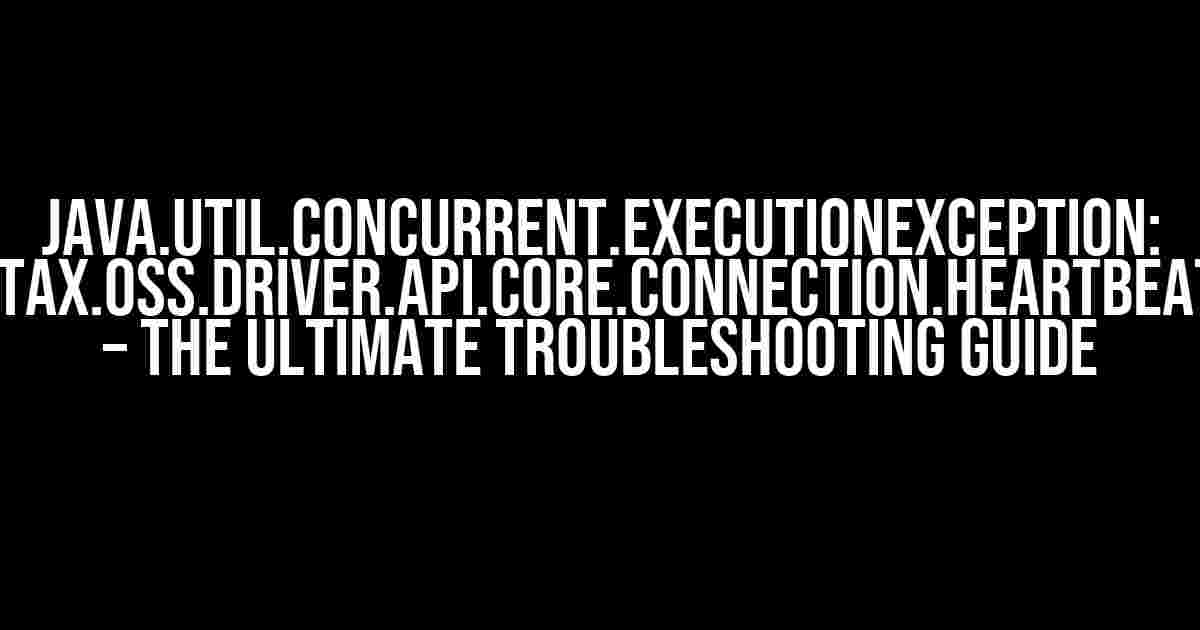Are you tired of getting the dreaded java.util.concurrent.ExecutionException: com.datastax.oss.driver.api.core.connection.HeartbeatException error in your Cassandra-based application? Do you want to know the root cause of this issue and how to fix it once and for all? Look no further! In this comprehensive guide, we’ll delve into the world of Cassandra connections, heartbeats, and execution exceptions to provide you with clear and direct instructions on how to troubleshoot and resolve this problem.
What is a HeartbeatException?
A HeartbeatException is thrown when a Cassandra node does not respond to a heartbeat request within a certain timeframe. Heartbeats are periodic checks performed by the Cassandra driver to ensure that the connection to the node is still active. When a node fails to respond, it indicates that the connection is stale or lost, and the driver will attempt to re-establish the connection.
Symptoms of a HeartbeatException
- Your application suddenly stops responding or becomes unresponsive.
- You notice an increase in latency or timeouts when interacting with your Cassandra cluster.
- You see the following error message in your logs:
java.util.concurrent.ExecutionException: com.datastax.oss.driver.api.core.connection.HeartbeatException.
Common Causes of HeartbeatExceptions
Before we dive into the solutions, let’s explore some common reasons why HeartbeatExceptions occur:
- Network Issues: Network congestion, packet loss, or high latency can prevent heartbeats from reaching the Cassandra node.
- Node Overload: When a Cassandra node is overwhelmed with requests, it may not respond to heartbeats in a timely manner.
- Node Failure: A failed or restarted node will not respond to heartbeats, causing the driver to throw a
HeartbeatException. - Driver Configuration: Misconfigured driver settings, such as incorrect timeouts or connection pooling, can lead to
HeartbeatExceptions.
Troubleshooting Steps
Now that we’ve covered the symptoms and causes, let’s move on to the troubleshooting steps:
Step 1: Check the Cassandra Node Status
Verify that the Cassandra node is up and running by:
- Checking the node’s system.log file for errors.
- Running the
nodetool statuscommand to check the node’s status. - Checking the Cassandra cluster’s overall health using
nodetool describecluster.
Step 2: Analyze the Driver Configuration
Review your driver configuration to ensure:
- The
heartbeat_intervalis set to a reasonable value (default is 30 seconds). - The
heartbeat_timeoutis set to a reasonable value (default is 30 seconds). - The
connection_pool_sizeis adequate for your workload. - The
max_requests_per_connectionis set to a reasonable value.
Step 3: Monitor Network Activity
Use tools like:
tcpdumpto capture and analyze network traffic.wiresharkto inspect packet captures.netstatto check for network congestion or connection issues.
Step 4: Review Application Logs
Inspect your application logs for:
- Any errors or exceptions related to Cassandra connections.
- Slow or failed queries that may be contributing to the
HeartbeatException.
Solutions and Workarounds
Now that we’ve identified the root cause of the issue, let’s explore some solutions and workarounds:
Solution 1: Adjust Driver Configuration
Cluster cluster = Cluster.builder()
.addContactPoint("localhost")
.withPoolingOptions(new PoolingOptions()
.setHeartbeatIntervalSeconds(60)
.setHeartbeatTimeoutSeconds(30))
.build();
Increase the heartbeat_interval and heartbeat_timeout to give the node more time to respond to heartbeats.
Solution 2: Implement Connection Pooling
Cluster cluster = Cluster.builder()
.addContactPoint("localhost")
.withPoolingOptions(new PoolingOptions()
.setCoreConnectionsPerHost(4)
.setMaxConnectionsPerHost(10))
.build();
Implement connection pooling to reuse existing connections and reduce the load on the Cassandra node.
Solution 3: Use Token-Aware Load Balancing
LoadBalancingPolicy loadBalancingPolicy = new TokenAwarePolicy(
new DCAwareRoundRobinPolicy("datacenter1")
);
Cluster cluster = Cluster.builder()
.addContactPoint("localhost")
.withLoadBalancingPolicy(loadBalancingPolicy)
.build();
Use token-aware load balancing to distribute requests across nodes based on their token ranges.
Solution 4: Retry Failed Requests
RetryPolicy retryPolicy = new ExponentialRetryPolicy(500, 3);
Cluster cluster = Cluster.builder()
.addContactPoint("localhost")
.withRetryPolicy(retryPolicy)
.build();
Implement a retry policy to retry failed requests with an exponential backoff strategy.
Conclusion
In this comprehensive guide, we’ve covered the symptoms, causes, and troubleshooting steps for the java.util.concurrent.ExecutionException: com.datastax.oss.driver.api.core.connection.HeartbeatException error. By following the solutions and workarounds provided, you should be able to resolve this issue and ensure the reliability and performance of your Cassandra-based application.
| Cause | Solution |
|---|---|
| Network Issues | Monitor network activity, adjust driver configuration |
| Node Overload | Implement connection pooling, retry failed requests |
| Node Failure | Use token-aware load balancing, implement retry policy |
| Driver Configuration | Adjust driver configuration, implement connection pooling |
Remember to stay vigilant and monitor your application’s performance to prevent future occurrences of this error. Happy troubleshooting!
Frequently Asked Question
Get answers to the most frequently asked questions about java.util.concurrent.ExecutionException: com.datastax.oss.driver.api.core.connection.HeartbeatException
What is java.util.concurrent.ExecutionException: com.datastax.oss.driver.api.core.connection.HeartbeatException?
This exception is thrown when a Cassandra connection heartbeat times out, indicating that the connection is no longer active. This can happen due to network issues, server overload, or misconfigured Cassandra settings.
What are the common causes of java.util.concurrent.ExecutionException: com.datastax.oss.driver.api.core.connection.HeartbeatException?
Common causes include network connectivity issues, high latency, Cassandra node failures, and incorrect or outdated Cassandra driver configurations. Additionally, firewalls, proxies, or load balancers can also contribute to this exception.
How can I troubleshoot java.util.concurrent.ExecutionException: com.datastax.oss.driver.api.core.connection.HeartbeatException?
To troubleshoot, check your Cassandra node status, verify network connectivity, and review Cassandra driver configurations. Also, enable debug logging to gather more information about the exception. You can also use tools like `cqlsh` or `nodetool` to diagnose Cassandra node issues.
Can I prevent java.util.concurrent.ExecutionException: com.datastax.oss.driver.api.core.connection.HeartbeatException from occurring?
Yes, you can prevent this exception by implementing connection timeouts, retries, and backoff strategies in your Cassandra driver configuration. Additionally, ensure that your Cassandra nodes are properly configured, and your application is designed to handle connection timeouts and failures.
How do I handle java.util.concurrent.ExecutionException: com.datastax.oss.driver.api.core.connection.HeartbeatException in my application?
Handle the exception by catching and retrying the failed operation, or by implementing a circuit breaker pattern to prevent further requests from being sent to a faulty Cassandra node. You can also consider using a Cassandra driver that provides built-in retry and fallback mechanisms.



